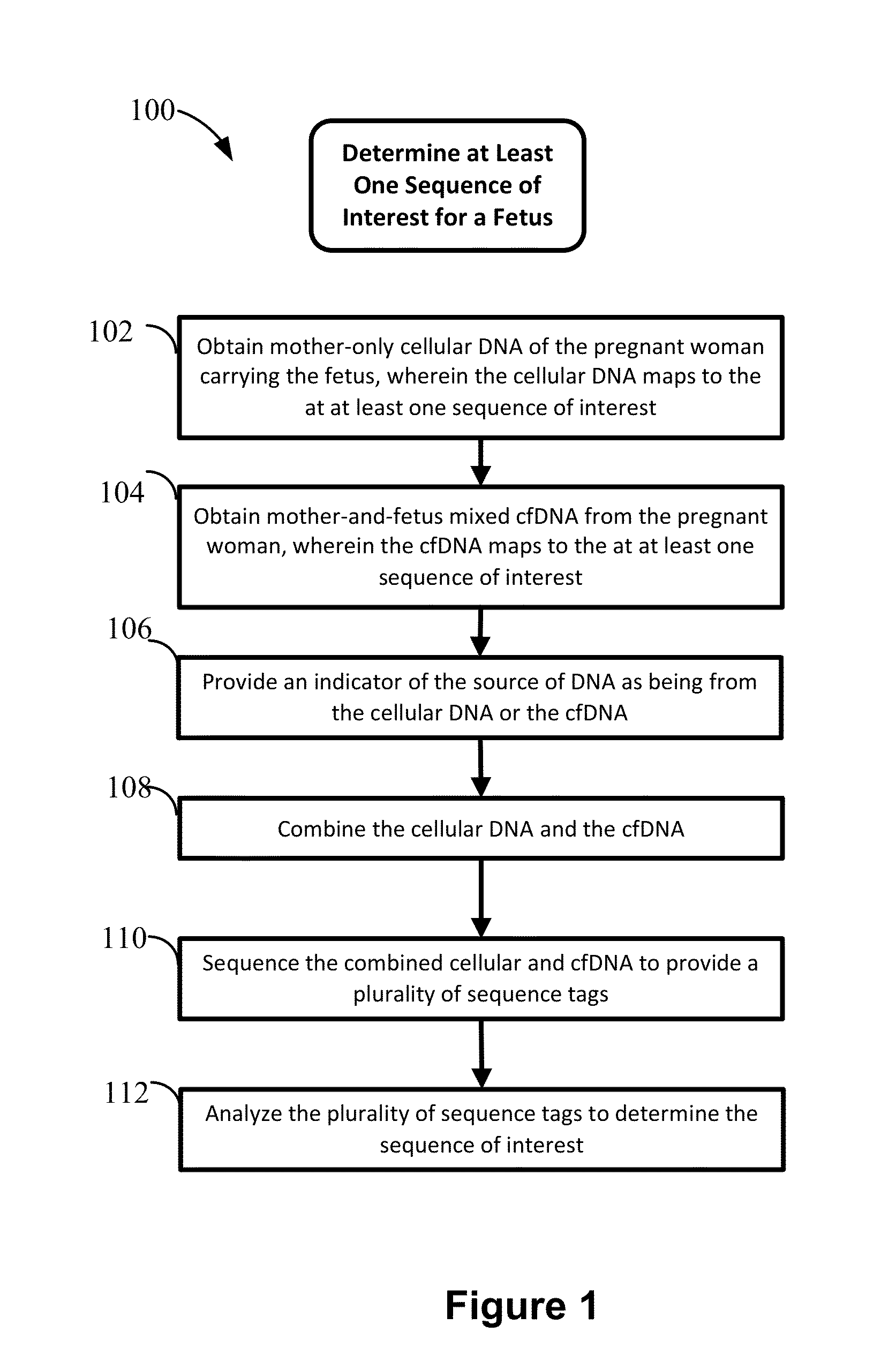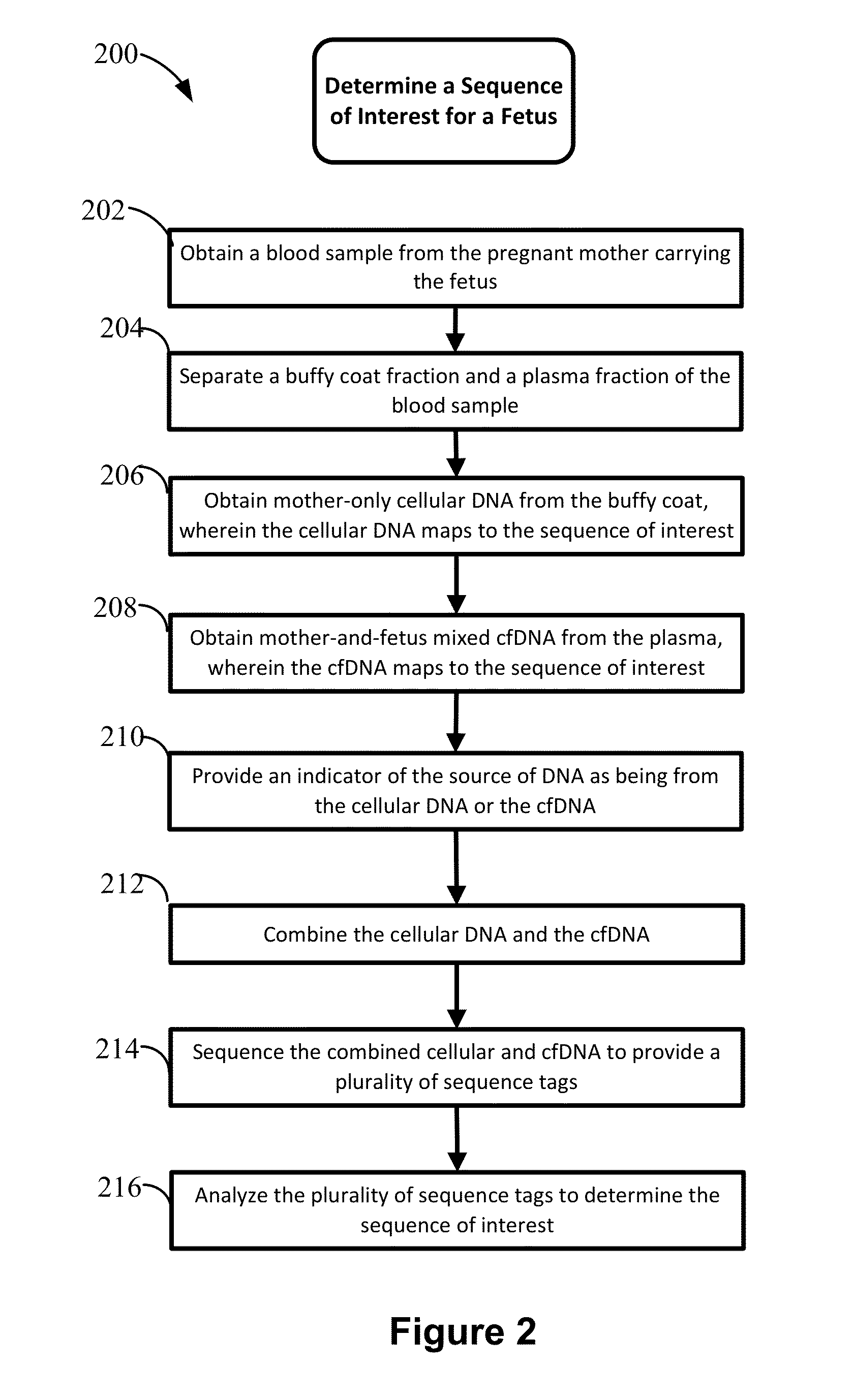Non-invasive prenatal diagnosis of fetal genetic condition using cellular DNA and cell free DNA
a fetal genetic and cell-free technology, applied in the field of non-invasive prenatal diagnosis of fetal genetic condition using cellular dna and cell-free dna, can solve the problems of difficult to differentiate if, methods that can accommodate a relative skew in quantity, and difficult data analysis
- Summary
- Abstract
- Description
- Claims
- Application Information
AI Technical Summary
Benefits of technology
Problems solved by technology
Method used
Image
Examples
example 1
Preparation and Sequencing of Primary and Enriched Sequencing Libraries
[0376]a. Preparation of Sequencing Libraries—Abbreviated Protocol (ABB)
[0377]All sequencing libraries, i.e., primary and enriched libraries, were prepared from approximately 2 ng of purified cfDNA that was extracted from maternal plasma. Library preparation was performed using reagents of the NEBNext™ DNA Sample Prep DNA Reagent Set 1 (Part No. E6000L; New England Biolabs, Ipswich, Mass.), for Illumina® as follows. Because cell-free plasma DNA is fragmented in nature, no further fragmentation by nebulization or sonication was done on the plasma DNA samples. The overhangs of approximately 2 ng purified cfDNA fragments contained in 40 μl were converted into phosphorylated blunt ends according to the NEBNext® End Repair Module by incubating in a 1.5 ml microfuge tube the cfDNA with 5 μl 10× phosphorylation buffer, 2 μl deoxynucleotide solution mix (10 mM each dNTP), 1 μl of a 1:5 dilution of DNA Polymerase I, 1 μl T...
example 2
Determining Sry Gene Using Fetal Cellular DNA and Mother-and-Fetus cfDNA
[0386]This example illustrates that the methods and systems disclosed herein may be used to determine a Y-chromosome specific sry gene using cfDNA and fetal cellular DNA obtained from a maternal blood sample.
[0387]In this example, cfDNA are isolated and indexed cfDNA library are prepared from the isolated cfDNA. In this example, the plasma or serum from maternal blood sample was harvested by a low-speed centrifugation at 1,600 g. A maternal blood sample was spin for 15 mins at 4° C. Then the upper layer of plasma was removed, then the plasma was spun 2 times for 10 mins. at 16,000 g to ensure removal of all cellular sources of DNA. Then Tn5 mediated transposon tagging (Nextera) was used to create an indexed sequencing library directly from 15 ul of prespun plasma or serum (or kit purified cell free DNA). NGS libraries prepared from purified cfDNA as shown in are shown in FIG. 18.
[0388]In addition, circulating fe...
PUM
| Property | Measurement | Unit |
|---|---|---|
| density | aaaaa | aaaaa |
| density | aaaaa | aaaaa |
| fluorescence in situ hybridization | aaaaa | aaaaa |
Abstract
Description
Claims
Application Information
 Login to View More
Login to View More - R&D
- Intellectual Property
- Life Sciences
- Materials
- Tech Scout
- Unparalleled Data Quality
- Higher Quality Content
- 60% Fewer Hallucinations
Browse by: Latest US Patents, China's latest patents, Technical Efficacy Thesaurus, Application Domain, Technology Topic, Popular Technical Reports.
© 2025 PatSnap. All rights reserved.Legal|Privacy policy|Modern Slavery Act Transparency Statement|Sitemap|About US| Contact US: help@patsnap.com



